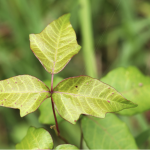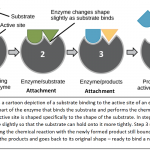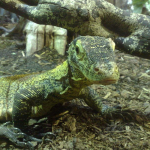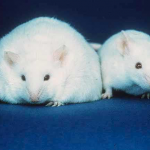Oct 29, 2020

By Jenna Beam Earlier this month, I decided to embark on my first backpacking trip in Congaree National Park in South Carolina (be warned: beautiful, but mosquito central). While walking through the forest, my fellow backpacker pointed out a massive vine of poison ivy… right where I was about to step! And that’s when I […]
Oct 29, 2020

By Brandon Le Does life exist outside the confines of our home planet? If this question captivates you, you’d find good company among astrobiologists – multidisciplinary scientists who seek to understand the origins, evolution, and distribution of life beyond Earth. Many astrobiologists agree that the special conditions allowing life to emerge on Earth are rare, […]
Oct 29, 2020

By Zoe Terwilliger Substrate (noun. /SUB-strate/) What does it mean? In biochemistry, a substrate is a molecule that an enzyme acts on. Substrates attach to enzymes and undergo an enzyme-catalyzed chemical reaction to form a new substance: the product. How do I use it in a sentence? ATPases are enzymes that all bind the substrate […]
Oct 29, 2020

By Priscila Santa Rosa Parthenogenesis (Noun. /par-theh-no-JEH-ne-sis/) What does it mean? Parthenogenesis is a type of asexual reproduction in animals where the egg can develop without being fertilized by a sperm. Parthenogenetic embryos have no father, which means that they have the genetic material only from the mother. Parthenogenesis is a common type of […]
Oct 28, 2020

By Whitney Bell Technique Name: Mammalian Cell Culture Difficulty Rating: 4/5 petri dishes depending on the day. Mammalian cell culturing can be simple if you’re using immortalized cell lines (like fast-growing cancer cells; however, can be more difficult and time consuming if you are using primary cells lines to make sure they are not differentiating […]
Oct 28, 2020

By Taylor Tibbs It is that time of year again: the morning air is crisp and you can feel a bit of a chill; the summer trees that were once a lush and deep green are beginning to turn into a splendor of reds, yellows, and oranges. This colorful phenomenon seems to occur every year […]
Oct 24, 2020

By Emma Goldberg If you’ve ever woken up in the middle of the night and tried to reach for something on your nightstand, you know that it takes your eyes a few minutes to adjust to the darkness. Now, imagine being a fish living in the deepest depths of the ocean – a place where […]
Oct 22, 2020

By Carolina A. Herrera Vaccines train your immune system to fight against harmful invading pathogens, which are microorganisms (bacteria, viruses, fungi and parasites) that can cause disease. Vaccines contain dead or weakened pathogens, or distinctive pieces of a pathogen such as proteins or polysaccharides (sugars) that activate the immune system. The immune system is a […]
Oct 22, 2020

By Anastacia Wienecke Hemocytometer (noun. /hee-mo-sai-TAA-meh-ter/) What does it mean? One tool that many biological researchers have in their laboratory toolboxes is a hemocytometer. This device is useful for counting the number of cells within a 10 microliter (10 millionths of a liter) volume of liquid. The hemocytometer looks like a thick microscope slide and it […]
Oct 21, 2020

By Mohamed Nasr Gram Staining Fun Rating: What is the general purpose? Gram staining is used to differentiate between two large groups of bacteria according to their cell wall structure differences (Figure 1). Why do we use it? Gram staining is an essential technique in the field of microbiology. It is used in a wide […]
Oct 19, 2020

By Riya Gohil Alex Stutzman is a third year Ph.D. candidate at the University of North Carolina at Chapel Hill in the Genetics and Molecular Biology Department. Alex is dedicated to her research in the Dowen and McKay labs at UNC, and also to engaging diverse scientists to address the racial injustices that exist in […]
Oct 19, 2020

Escrito y traducido por Regina Fernandez Imagina que acabas de terminar de comer un delicioso Bojangles’ famous chicken ‘n biscuits. Un amigo se sienta enseguida de ti y te ofrece un postre. El postre es un pedazo grande de pastel de chocolate servido con dos bolas de nieve de vainilla. ¡Se ve delicioso! Pero te […]
Oct 19, 2020

By Regina Fernandez Imagine you just finished eating some delicious Bojangles’ famous chicken ‘n biscuits. Your friend sits next to you and offers a big piece of chocolate cake with two scoops of vanilla ice cream for dessert. Dessert looks delicious!! But you feel full and you don’t feel like eating anymore food. So, you […]
Oct 15, 2020

By Alec Chaves If you’ve been following my previous blog posts, you’ll notice I like to talk about skeletal muscle. This is because, in my opinion, skeletal muscle is the coolest and most fascinating organ to study. Not only do skeletal muscles allow you to move, they also release chemicals called cytokines, which communicate with […]
Oct 14, 2020

By Rami Major Allele (Noun. /uh-LEEL/) What does it mean? Alleles can be considered versions of a gene, and a single gene can have many alleles. Humans have two alleles for a single gene: one from the mother, and the other from the father. The relationship between the two alleles that you have will influence […]
Oct 13, 2020

By Riya Gohil Technique Name: Western Blot Fun Rating: Difficulty Rating: What is the general purpose? Western Blots utilize gel electrophoresis to separate protein by size and use antibodies to detect specific proteins molecules within a mixture of various proteins. Why do we use it? Western Blots are useful to detect the presence and amount of […]
Oct 08, 2020

By Nicole Gadda Do you know the story of Typhoid Mary? Mary Mallon, otherwise known as Typhoid Mary, was born in Ireland in 1869 and immigrated to the United States in 1883. Mary worked as a cook and later became infamous for unknowingly spreading typhoid fever to the families she worked for. Typhoid fever is […]
Oct 08, 2020

By Zoe Terwilliger Enzyme (noun / ENZ-eye-m) What does it mean? An enzyme is a molecule that “speeds up” the rate of a chemical reaction. Enzymes are a type of protein, so they are made of amino acids like all other proteins. Enzymes take substrates, which are molecules that will undergo reaction to form a […]
Oct 06, 2020

By Sean Gay Technique Name: Behavior Assays: The Morris Water Maze [Fun] Rating: On a scale from fun and easy like Bill Nye the Science Guy to difficult for Einstein, the technique is….. One Einstein: The results are difficult to interpret. Four Bill Nyes: The actual experiment is easy to perform and generates loads of data. […]
Oct 01, 2020

Por Alexander Gómez-A Aunque el elevador ha estado fuera de servicio por cerca de una semana, Alex, un adulto de 28 años de edad, continúa ubicándose frente a el, presionando el botón y esperando por su llegada. Después de algún tiempo, Alex recuerda que el elevador no está funcionando y usa las escaleras. ¿Por qué […]
Oct 01, 2020

By Alexander Gómez-A Although the elevator has been out-of-order for about one-week, Alex, 28, continues standing in front of it, pressing the button, and waiting for it to arrive. Then, after some time, he remembers that the elevator is not working and use the stairs. Why did this happen to Alex? Was he a distracted […]



















